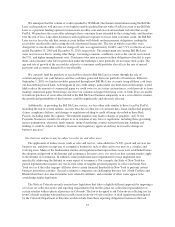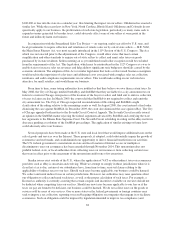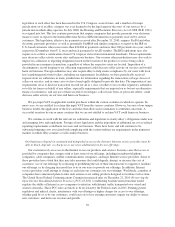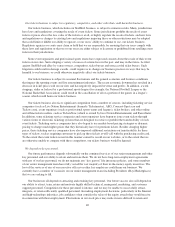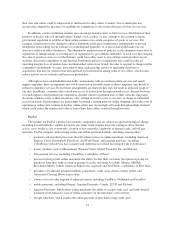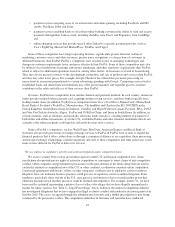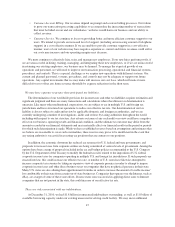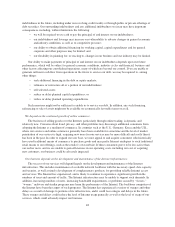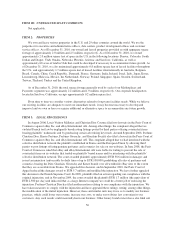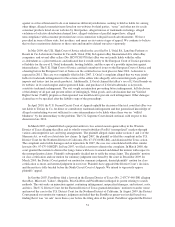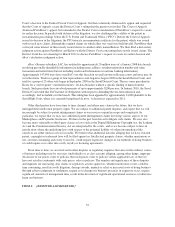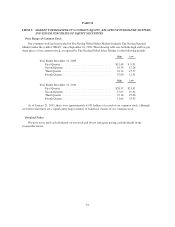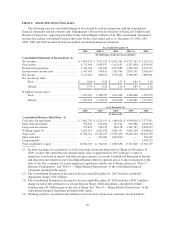eBay 2010 Annual Report Download - page 52
Download and view the complete annual report
Please find page 52 of the 2010 eBay annual report below. You can navigate through the pages in the report by either clicking on the pages listed below, or by using the keyword search tool below to find specific information within the annual report.•Customer Account Billing. Our revenues depend on prompt and accurate billing processes. Our failure
to grow our transaction-processing capabilities to accommodate the increasing number of transactions
that must be billed on our and our subsidiaries’ websites would harm our business and our ability to
collect revenue.
•Customer Service. We continue to focus on providing better and more efficient customer support to our
users. We intend to provide an increased level of support (including an increasing amount of telephone
support) in a cost-effective manner. If we are unable to provide customer support in a cost-effective
manner, users of our websites may have negative experiences, current and future revenues could suffer,
our costs may increase and our operating margins may decrease.
We must continue to effectively hire, train, and manage new employees. If our new hires perform poorly, if
we are unsuccessful in hiring, training, managing, and integrating these new employees, or if we are unsuccessful
in retaining our existing employees, our business may be harmed. To manage the expected growth of our
operations and personnel, we will need to improve our transaction processing, operational and financial systems,
procedures, and controls. This is a special challenge as we acquire new operations with different systems. Our
current and planned personnel, systems, procedures, and controls may not be adequate to support our future
operations. Any capital investments that we may make will increase our cost base, which will make it more
difficult for us to offset any future revenue shortfalls by expense reductions in the short term.
We may have exposure to greater than anticipated tax liabilities.
The determination of our worldwide provision for income taxes and other tax liabilities requires estimation and
significant judgment and there are many transactions and calculations where the ultimate tax determination is
uncertain. Like many other multinational corporations, we are subject to tax in multiple U.S. and foreign tax
jurisdictions and have structured our operations to reduce our effective tax rate. Our determination of our tax
liability is always subject to audit and review by applicable domestic and foreign tax authorities, and we are
currently undergoing a number of investigations, audits and reviews by taxing authorities throughout the world,
including with respect to our tax structure. Any adverse outcome of any such audit or review could have a negative
effect on our business, operating results and financial condition, and the ultimate tax outcome may differ from the
amounts recorded in our financial statements and may materially affect our financial results in the period or periods
for which such determination is made. While we have established reserves based on assumptions and estimates that
we believe are reasonable to cover such eventualities, these reserves may prove to be insufficient in the event that
any taxing authority is successful in asserting tax positions that are contrary to our positions.
In addition, the economic downturn has reduced tax revenues for U.S. federal and state governments, and
proposals to increase taxes from corporate entities are being considered at various levels of government. Among the
options have been a range of proposals included in the tax and budget policies recommended to the U.S. Congress
by the U.S. Department of the Treasury to modify the federal tax rules related to the imposition of U.S. federal
corporate income taxes for companies operating in multiple U.S. and foreign tax jurisdictions. If such proposals are
enacted into law, this could increase our effective tax rate. A number of U.S. states have likewise attempted to
increase corporate tax revenues by taking an expansive view of corporate presence in order to attempt to impose
corporate income taxes and other direct business taxes on companies that have no physical presence in their state.
Many U.S. states are also altering their apportionment formulas in order to increase the amount of taxable income/
loss attributable to their state from certain out-of-state businesses. Companies that operate over the Internet, such as
eBay, are a target of some of these state efforts. If more states were successful in applying direct taxes to Internet
companies that are not present in the state, this could increase of our effective tax rate.
There are risks associated with our indebtedness.
At December 31, 2010, we had $1.8 billion in unsecured indebtedness outstanding, as well as $1.8 billion of
available borrowing capacity under our existing unsecured revolving credit facility. We may incur additional
47


